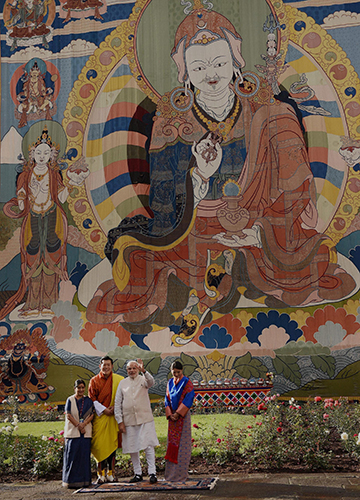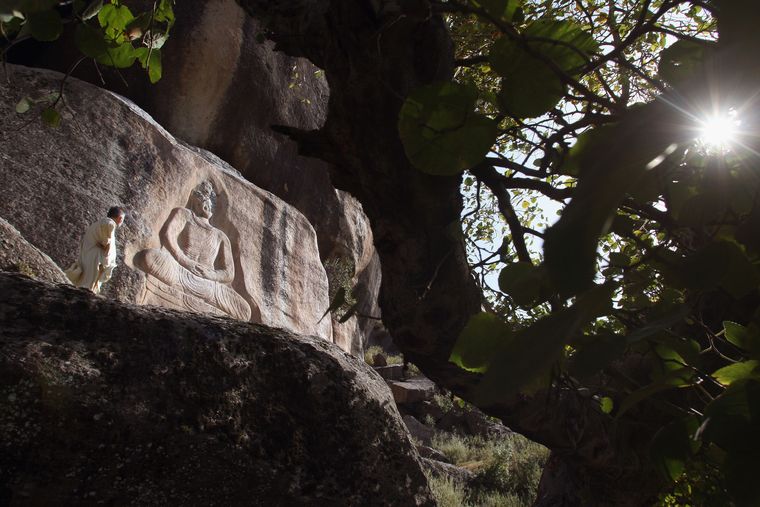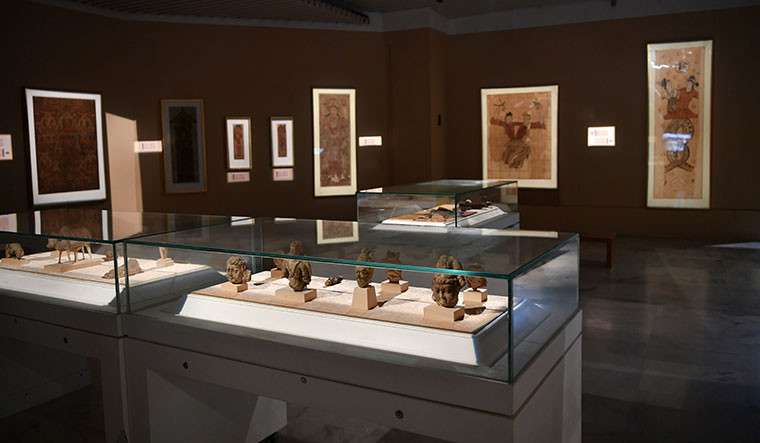The Buddha smiles. Not as the codename for India’s nuclear tests this time, but in stone, bang in the middle of the controversial Central Vista in Delhi. The Buddha sits in meditative silence in an upcoming museum dedicated to him. The newest addition to Delhi’s already crammed historic landscape, the museum is part of the Narendra Modi government’s ambitious soft power project of invoking India’s first God to cross the seas—courtesy emperor Ashoka—to cement deeper ties with countries sharing the same spiritual heritage.
Buddhism has been India’s most powerful export. It has also been a key element of Modi’s ‘Act East’ policy. The Buddha has been at the heart of diplomacy since the time of Ashoka, who tried to spread Buddhist principles to the neighbouring countries. Several centuries later, one of independent India’s first diplomatic battles was over the Buddha relics.
The relics from Sanchi, which were taken out in the 19th century by British archaeologists, were kept at the Victoria and Albert Museum in London. It became an emotive issue for the Maha Bodhi Society, which wanted the relics to be returned to a new vihara opened in Sarnath in 1932.
The request was granted seven years later, but the return was delayed because of World War II. After India’s independence, the new government under Jawaharlal Nehru insisted on the return of the relics in their original casket and finally got them back. At a grand ceremony held in Calcutta on January 14, 1949, Nehru handed over the casket to Syama Prasad Mookerjee, the president of the society.
Nehru spun the Buddha’s message into his idea of greater affinity for Asia. And Modi has chosen to make it a visible part of his diplomatic outreach, almost like a “strategic asset”, according to former foreign secretary Lalit Mansingh.
Although the Buddha was born in Lumbini, which is in present-day Nepal, his karmabhoomi was India. The story is well known. Prince Siddhartha of the Shakyamuni clan left the comfort of his palace to find the answer to suffering in the world. It was at Bodh Gaya (now in Bihar), under a tree, that he found the answer. He travelled around and taught his message of compassion, tolerance and of humanity. His ideas were revolutionary as they negated caste and gender barriers and showed the world the path to nirvana. Even centuries later, the Buddha’s ideas retain their relevance.
“Humanity faces a crisis today in the form of Covid,’’ said Modi earlier this year on Vesak day, which commemorates the Buddha’s birthday. “Lord Buddha has become even more relevant. India has shown how we can face the greatest of challenges by walking on his path. Countries are joining hands with each other and becoming each other’s strength, taking the values of the Buddha.”
History, indeed, backs up India’s claim to the Buddha’s legacy, which is essential for its superpower ambitions. It was from India that Buddhism spread peacefully across Asia—to Sri Lanka, Cambodia, China, Indonesia, Laos, Afghanistan, Mongolia, Vietnam and Japan—through trade across the seas and overland, and through evangelisation by nuns and monks.
“Buddhism is an Indian product,’’ said scholar-diplomat P. Stobdan. “It does not exist in India in that form, but that does not mean that India doesn’t own it. If you don’t own Buddhism, then someone else will stake claim for it. In this case, China is increasingly trying to appropriate Buddhism. With the Taliban’s return in Afghanistan, we have seen that religion, culture and history are more powerful than American weapons.”
With China stepping up its efforts to claim the Buddhist legacy, history has indeed emerged as yet another frontier for great power rivalry. The past is not only about identity, but also geostrategy. Amitabh Mathur, former adviser to the home ministry on Tibetan affairs, said China, which did not allow religion to be practised in the country, now claims itself to be the largest Buddhist nation in the world. “At a communist party congress a few years ago, it was claimed that Buddhism was indigenous to China and that China nurtured it,” he said.
China tries to use Buddhism politically against India, pointedly, because of Tibet. With the 14th Dalai Lama taking refuge in India in 1959, the future of Tibetan Buddhism is tied together with India. “China needs Buddhism to pacify Tibet,” said Mathur. China also wants to build people-to-people relations with countries with which it has a political interest. The outreach is immense as 70 per cent of the world’s Buddhist population lives in the region. And, India is surrounded by Buddhist nations.
Since his first term, Modi has realised this. The Buddha museum is more than just about putting an Indian context to the Buddha’s story, but it also caters to believers. The relics of the Buddha, which have been visited by royals, heads of state and monks, will finally have a home. Devotees from across the world will be able to pay a visit and pray.
“Any nation that controls Buddhism will control Asia,’’ said Stobdan. “Modi understood it and wants to use Buddhism to make India a major power.’’ His first visit as prime minister was to a Buddhist country, Bhutan. “When he visited China, he went to Xi’an, where a Tamil Brahmin preached Buddhism many centuries ago,’’ said Stobdan.
During his visits to Sri Lanka, Modi tried to woo the Buddhist clergy. He was the first Indian prime minister to visit Mongolia, another Buddhist stronghold. During his Japan trip in 2016, Modi visited two Buddhist temples, and Buddhism found a mention in the joint statement. The ministry of external affairs now has a cell to execute projects where the services of the Archaeological Survey of India are requested by different countries. Buddhist heritage is a natural candidate and from Bagan to Bamiyan, there is an Indian element of conservation.
India has been carefully using the Buddha relics as a diplomatic tool. In 2012, after annoying Sri Lanka by voting against it in the UN Human Rights Council, India made up by sending the sacred Kapilavastu relics (fragments of Buddha’s bones) to the island nation, following a request by president Mahinda Rajapaksa. “In a week, half of Sri Lanka had turned up to see them,’’ said Ravinder Singh, who was then secretary, ministry of culture.
During a virtual summit with Rajapaksa (who now serves as prime minister) last year, Modi promised to send the relics to Sri Lanka again. “If India plays her cards cleverly, Sri Lanka and India can be best friends,” said Damenda Porage, a Buddhist leader from Sri Lanka. “It is not just friendship, we share a blood relationship. Buddhism is the bridge. Sri Lanka has been a Buddhist country for 25 centuries.”
China, meanwhile, is making rapid inroads, especially by linking Buddhism with its economic policy. “The Belt and Road Initiative is the political geography of Buddhism,” said Stobdan. China was surprised to see how Indians spread Buddhism 2,000 years ago, without using force, instead through trade routes. The Chinese are using the same methodology to spread economic power.”
China’s biggest agenda in this regard has been to limit the Dalai Lama’s influence. It has taken over the Common Text Project launched by the International Council of Day of Vesak at the Maha Chulalongkorn University in Thailand. The project, which is aimed at creating a common text in English on prominent Buddhist traditions from Tibetan, Pali, Sanskrit and Chinese sources, is now being sanitised of Tibetan voices. Chinese texts are listed as the source of most of the entries. Thailand even refused entry to Geshe Ngawang Samten, vice chancellor of the University of Tibetan Studies, based in Sarnath, for nearly two years.
China has set up the Nanhai Buddhism Academy in Hainan province as an alternative to the floundering Nalanda University, with an abbot from Lumbini as its head. It has also launched its own Buddhist conclave called the World Buddhist Forum.
As India flexes its diplomatic muscle in the Buddhist circuit, its competition is not just with China. Although India accepts that the Buddha was born in Lumbini, it disputes Nepal’s claim that Kapilavastu, the location of the Buddha’s childhood home, lies within its territory. Nepal says the Buddha was always enlightened, even at the time of his birth, downplaying the significance of Bodh Gaya. “China is promoting Lumbini as a rival to Bodh Gaya,” said Mathur. “The Chinese say all the Buddhas were born enlightened so there is nothing special about Bodh Gaya; Lumbini, where Siddhartha was born, is equally, if not more, important. Their purpose, of course, is to gain a foothold on our border.”
In Myanmar, too, there is Sino-Indian tiff over Buddhism. The Chinese were angry after the Myanmar government decided to seek Indian help for restoring the famous Ananda temple. Myanmar had to hand over another shrine to China for similar work.
Mongolia is another battleground. The title of the Dalai Lama comes from Mongolia, which further complicates the situation. In November 2016, when the Dalai Lama went to Mongolia to authenticate the identity of the tenth incarnation of the third highest-ranking lama of Tibetan Buddhism, China issued a stern warning.
It did not help that India had facilitated the reintroduction of Buddhism to Mongolia in 1990 after 70 years of communist rule. Kushok Bakula, India’s first monk ambassador posted to the country in 1989, was at the heart of the revival. His biggest contribution was perhaps the establishment of the Pethub Stangey Choskor Ling monastery in Ulaanbaatar.
Also read
- India should share its ancient knowledge with the world: The Dalai Lama
- It is tempting to think Buddhism can boost India’s influence in the Indo-Pacific
- Stories about disappearance of Buddhism in India are grossly exaggerated
- What triggered a Hindu-Buddhist dispute in the 19th century in Bodh Gaya
- Abode of peace
- The Buddha trail
Like India, Pakistan, too, seems to be waking up to its Buddhist past. In the grand reshaping of Pakistan under Prime Minister Imran Khan, the Buddhist heritage has a key role to play. Pakistan has plans to establish Gandhara International University in Taxila in an effort to revive the Buddhist university of ancient Taxila. Meanwhile, the Swat valley, believed to be the birthplace of Guru Padmasambhava, is being developed as a heritage destination, attracting devotees, especially from Bhutan. Pakistan is also slated to hold a big Buddhist conclave next year.
In Delhi, however, despite the global interest in Buddhism, there are serious challenges ahead for India’s plans to develop the legacy as a diplomatic tool. The new museum in Delhi is a small piece on the grand chessboard, and more needs to be done. For instance, the revival of Nalanda University has not been a success; the effort requires much more depth and academic rigour. Moreover, the outreach should be on a grand scale and should go beyond organising events. Also looming ahead is the battle for the next Dalai Lama. China has already announced that it will select the 15th Dalai Lama.
Apart from being one of India’s greatest cultural and spiritual exports, Buddhism has also played a key role in shaping modern India’s identity. The Sarnath lions are on the Indian currency and the government insignia, while the dharma wheel with its 24 spokes is at the centre of the national flag. Nonviolence or ahimsa, the core principle of the Indian freedom struggle and the basic tenet that Mahatma Gandhi lived by, came from the Buddha. The architect of the Constitution, B.R. Ambedkar, too, relied on Buddhism in his fight against caste oppression and untouchability.
“Vivekananda, Tagore, Gandhi, Mookerjee and Nehru, they all belong to the school which looks upon the Buddha as a cultural, spiritual and ethical icon,’’ said senior Congress leader Jairam Ramesh whose book, The Light of Asia: The Poem That Defined The Buddha, documents the big discovery of the Buddha in the west. “But there is another school—of Jyotiba Phule, Narayana Guru, D.D. Kosambi and, of course, Ambedkar, who looked upon the Buddha as a political revolutionary and a social radical. For the first group, the Buddha was all about love, compassion and tolerance. But for the second, he represented social revolution and an attack on caste prejudice.”
The Buddha, therefore, looms large over the two sides of the socio-political revolution in India: the freedom movement under Gandhi’s leadership and the battle for equality led by Ambedkar. His unmistakable imprint is now becoming increasingly visible in the Indian foreign policy as well. And his message is something India needs to live by. As the Dalai Lama wrote in the preceding pages of THE WEEK, “The ultimate purpose of Buddhism is to serve and benefit humanity. Whether we consider ourselves Buddhists or not, we can all benefit from adopting the tried and tested principles of karuna and ahimsa as the basis for creating a happier, more peaceful world.”




